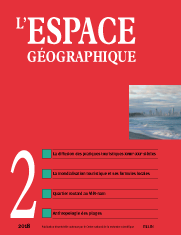

Tourism: A geographic perspective
The logics of tourism expansion throughout the world: A geohistorical approach (3 fig.; 2 photos)
The current distribution of tourist sites throughout the world is the result of a process of spatial diffusion, which started in Europe during the eighteenth century. Based on sketch maps of an unpublished database of almost 3,000 tourist sites, the article details four important milestones in the globalization process of tourism: its initial diffusion in Europe, its subsequent spatial expansion as part of the colonization and its spread in the second half of the twentieth century. The paper then examines some key factors to explain the dissemination of tourist sites in the world. It highlights the role of physical circulations in the production of touristic sites, along with other cultural, technical and economic logics.
keywords: CAPITALISM, DIFFUSION, GLOBALIZATION, PRACTICE, TOURISM
Constructing the backpackers’ district of Pham Ngu Lao (Ho Chi Minh City, Vietnam). Dynamics of power and inequality in the globalization of tourism (5 fig.: 2 photos)
Relying on an approach that intersects both tourism geography and urban studies, this paper aims to understand the production of the Pham Ngu Lao backpacker district in Ho Chi Minh City (Vietnam). It studies the various ways through which professionals, residents and authorities invest in this globalized economy, revealing the profoundly unequal access to touristic ressources for social groups that are excluded from the local interplay of stakeholders based on class, nationality, ethnicity, gender or age. Doing so, this study contributes to a decentered perspective on backpacker districts, and more generally on the so-called Global South, still too often considered as enclaves for international tourism.
keywords: BACKPACKERS’ DISTRICT, GLOBALIZATION, INEQUALITY, LOCAL ACTOR, TOURISM, VIETNAM
Tourism as an agent of socio-spatial interculturation? Seaside touristic practices in Bali and Java (Indonesia) (1 fig.; 4 photos)
A new interpretation of social relationships emerged in the 1990s in cultural psychology; based on the concept of interculturation, it helps to understand a co-constituted and yet contradictory phenomena: the transformation of existing cultures under the influence of social interactions and their persistence, fueled by the desire to preserve one's identity. Yet, geographers have not yet claimed this concept, deeply associated with spatial mobility and site-specific cultural encounters. Using the case of the Indonesian touristic practices on the seaside in Bali and Java, this paper aims to indicate how the study of touristic phenomena can favor the appropriation of the concept of interculturation.
keywords: GEOGRAPHY, INDONESIA, INTERCULTURATION, MODEL, TOURISM
Thinking and measuring social interaction distances on the recreation space of the beach (10 fig.; 1 photo)
This presentation is about the beach through a microgeographic analysis of the distances of interaction, which organize and define this tourism and leisure practice area. The study presented deals with the question of the “hidden dimensions” of the french atlantic coast beaches during peaks of summer attendance. The presentation is organized in three stages. First, we develop on the approach of beach attendance in geography and present the methodological choices necessary for the micro-geographical analysis. The spatial organization of the beach will then be approached through the examination of the distances separating the cells of beachgoers. The question of the distances of embarrassment and comfort will close this reflection.
keywords: BEACH, LEISURE, PRACTICE AREA, SPATIAL INTERACTION, TOURISM
Book reviews
In this issue of l’Espace géographique, you will find critical reviews of the following books
COCHET H., ANSSEUW W., FRÉGUIN-GRESH S. (2015). South Africa’s Agrarian Question. Prétoria: HSRC Press, 358 p. (David Blanchon, université Paris Nanterre) ISBN: 978-0-7969-2512-1
GAY J.-C. (2016). L’Homme et les Limites. Paris: Economica-Anthropos, 242 p. (Philippe Pelletier, université Lyon 2, UMR 5600 Environnement, ville, société) ISBN: 978-2-7178-6866-1
MIRUMACHI N. (2015). Transboundary Water Politics in the Developing World. Abingdon, New-York: Routledge, coll. «Earthscan», 190 p. (David Blanchon, université Paris Nanterre) ISBN: 978-0-415-81295-5
OLDENZIEL R., EMANUEL M., DE LA BRUHÈZE A.A., VERAART F. (dir.)(2016). Cycling Cities: The European Experience. Hundred Years of Policy and Practices. Eindhoven, Munich: Fondation for the History of Technology, LMU Rachel Carson Centre for Environment and Society, 256 p. (Sébastien Marrec, université Rennes 2) ISBN: 978-90-73192-46-1
COLLECTIF (2018). Un géographe de plein vent. Albert Demangeon (1872-1940). Paris: Bibliothèque Mazarine, Éditions des Cendres, 158 p. (Guy Baudelle, université Rennes 2) ISBN: 978-2-86742-273-7
L’espace géographique 1/18![]()
![]() L’espace géographique 3/18
L’espace géographique 3/18
For subscribe or buy this issue: BELIN
![]() L’Espace géographique: contents
L’Espace géographique: contents
Last modified: July 6, 2018